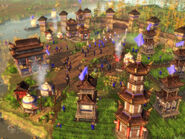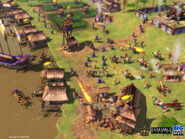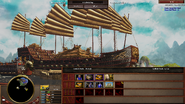| This article is about the civilization in Age of Empires III: The Asian Dynasties. For the other appearances of the faction in the series, see Chinese. |
The Chinese civilization's music theme in the Definitive Edition
The Chinese are one of the three playable civilizations featured in Age of Empires III: The Asian Dynasties based on the Great Qing Empire (大清帝國) during the reign of Kangxi (康熙) in the early modern era. They are widely considered to be an offensive civilization and similar to the Russians in employing lots of cheaper, comparatively weaker units.
Overview
The Chinese have the largest number of unique units in the game, and have second highest population cap, at 220 (the Haudenosaunee are capable of a 225 population cap through Earth Mother Ceremony in the Community Plaza). In addition to this, many Chinese wonders spawn free units, allowing for a numerical advantage. The Chinese also train units relatively fast although these units, like the Russians, are slightly weaker than ordinary units. Not all of the Chinese units are weak, however; the Flying Crow, a form of ballistic rocket, can be spawned with the Confucian Academy wonder while the Flamethrower, a devastating anti-melee infantry unit, can be trained from the castle from the Colonial Age. Instead of a separate barracks and stable, the Chinese train their troops in the joint War Academy.
The Chinese army has various units not seen in other civilizations, such as the Chu Ko Nu, a crossbow unit with an enhanced firing rate and easy to mass, but with low hit points, or the Changdao Swordsman, a cheap hand infantry unit, like a weak version of the Halberdier or Samurai, that can serve as an anti-cavalry troop in numbers. The Chinese also have interesting cavalry units such as the Iron Flail, a heavy horseman, the Steppe Rider, a raiding unit, the weakest heavy cavalry yet nevertheless the most useful heavy cavalry of China, the Keshik, a cheap mounted archer, and Meteor Hammer, which specializes in wrecking artillery. They have great upgrades, which makes their troops become very powerful, such as the "Double-Faced Armor" and the "Old Han Reforms" Home City Cards.
Features
- Has a population limit of 220
- Has Villages which combines the functions of a House and a Livestock Pen
- Train units in blocks as banner armies
- Starts with a Goat
- Villagers gather export as they gather resources
- Build the Consulate to ally with an European civilization and get their units and technologies by spending export
- Build Wonders to advance in Age
Unique units
 Villager: Villager that gathers resources.
Villager: Villager that gathers resources. Shaolin Master: Religious leader who trains Disciples, stuns Guardians, and has a chance to inflict a Critical Strike in combat. Explores, fights, and builds Town Centers and Trading Posts.
Shaolin Master: Religious leader who trains Disciples, stuns Guardians, and has a chance to inflict a Critical Strike in combat. Explores, fights, and builds Town Centers and Trading Posts. Disciple: Disciple to the Chinese Monk. Good against archers, skirmishers, and artillery.
Disciple: Disciple to the Chinese Monk. Good against archers, skirmishers, and artillery. Sentry: Quick-training, Pikeman who quickly loses hitpoints, becoming less effective over time.
Sentry: Quick-training, Pikeman who quickly loses hitpoints, becoming less effective over time. Irregular: Quick-training, musketeer who quickly loses hitpoints, becoming less effective over time.
Irregular: Quick-training, musketeer who quickly loses hitpoints, becoming less effective over time. Chu Ko Nu: Archaic Chinese crossbow that fires at an extremely fast rate. Good against infantry.
Chu Ko Nu: Archaic Chinese crossbow that fires at an extremely fast rate. Good against infantry. Qiang Pikeman: Foot warrior armed with a pike. Good against cavalry and buildings.
Qiang Pikeman: Foot warrior armed with a pike. Good against cavalry and buildings. Changdao Swordsman: Soldier armed with a very large sword. Good against cavalry.
Changdao Swordsman: Soldier armed with a very large sword. Good against cavalry. Arquebusier: Cheap Chinese foot soldier armed with a rifle. Good against infantry.
Arquebusier: Cheap Chinese foot soldier armed with a rifle. Good against infantry. Steppe Rider: Fast cavalry good at raiding villagers or buildings.
Steppe Rider: Fast cavalry good at raiding villagers or buildings. Keshik: Mongolian ranged cavalry. Good against cavalry.
Keshik: Mongolian ranged cavalry. Good against cavalry. Iron Flail: Chinese heavy cavalry. Good against archers, skirmishers, and artillery.
Iron Flail: Chinese heavy cavalry. Good against archers, skirmishers, and artillery. Meteor Hammer: Heavy cavalry that does hand damage from range. Good against archers, skirmishers, and artillery.
Meteor Hammer: Heavy cavalry that does hand damage from range. Good against archers, skirmishers, and artillery. Flamethrower: Chinese siege weapon that shoots fire at a short range. Better against infantry than buildings.
Flamethrower: Chinese siege weapon that shoots fire at a short range. Better against infantry than buildings. Hand Mortar: Weak light artillery. En masse, good against other artillery.
Hand Mortar: Weak light artillery. En masse, good against other artillery. Flying Crow: Heavy artillery that fires a rocket and is good against infantry or buildings.
Flying Crow: Heavy artillery that fires a rocket and is good against infantry or buildings. Fire Junk: Fire Junk. Rams anything on the water and explodes.
Fire Junk: Fire Junk. Rams anything on the water and explodes. War Junk: War Junk. Good at exploring, fishing or transport.
War Junk: War Junk. Good at exploring, fishing or transport. Fuchuan: Fuchuan. A heavy warship that can train units.
Fuchuan: Fuchuan. A heavy warship that can train units.
Unique buildings
 Village: Supports 20 population, which can be increased here with improvements. Also fattens livestock faster and trains Goats.
Village: Supports 20 population, which can be increased here with improvements. Also fattens livestock faster and trains Goats. Rice Paddy: Slow, infinite source of Food or Coin. Limited to 10 gatherers.
Rice Paddy: Slow, infinite source of Food or Coin. Limited to 10 gatherers. Monastery: Trains repentant outlaws and mercenaries. Provides Monk improvements.
Monastery: Trains repentant outlaws and mercenaries. Provides Monk improvements. Castle: A powerful defensive building that can also train and upgrade artillery.
Castle: A powerful defensive building that can also train and upgrade artillery. Consulate: Spend Export here to enter into relations with European powers and gain a powerful bonus. Also use Export to purchase European troops and technologies.
Consulate: Spend Export here to enter into relations with European powers and gain a powerful bonus. Also use Export to purchase European troops and technologies. War Academy: Chinese combination of Barracks and Stable. Trains infantry and cavalry in mixed groups. Also, upgrades infantry and cavalry.
War Academy: Chinese combination of Barracks and Stable. Trains infantry and cavalry in mixed groups. Also, upgrades infantry and cavalry.
Wonders
 Confucian Academy: Generates Flying Crow artillery automatically.
Confucian Academy: Generates Flying Crow artillery automatically. Porcelain Tower: Generates resources automatically. Configure it to produce different things.
Porcelain Tower: Generates resources automatically. Configure it to produce different things. Summer Palace: Generates Banner Armies automatically. Configure it to produce different things.
Summer Palace: Generates Banner Armies automatically. Configure it to produce different things. Temple of Heaven: Casts the Transcendence ability to heal your units.
Temple of Heaven: Casts the Transcendence ability to heal your units. White Pagoda: Increases attack and hitpoints of Shaolin Master and Disciple.
White Pagoda: Increases attack and hitpoints of Shaolin Master and Disciple.
Home City Cards
- Main article: Chinese Home City Cards
In-game dialogue
Chinese units (including native warriors and mercenaries except the Manchu mercenary horse archer, who speaks the unrelated Manchu language) speak Mandarin, but some of them have regional or ethnic influences:
- The Shaolin Master, Disciples, Chu Ko Nu, Qiang Pikemen, Arquebusiers, Flamethrowers, Flying Crows, Rattan Shields, and Iron Troopers speak with the proper pronunciations of modern-day standardized Mandarin.
- Villagers speak with a "regional" Han Chinese accent which transposes some intonations (Mandarin being a 4-tonal language) but does not otherwise alter syllables.
- Changdao Swordsmen, Steppe Riders, Keshiks, Iron Flails, Meteor Hammers, and Hand Mortars speak with Mongol or Manchu accents.
Words before the slash sign are rendered in simplified Chinese. Words after the slash sign are rendered in traditional Chinese.
General
- 准备就绪 / 準備就緒 [Zhǔnbèi jiùxù.] ("Ready")
- 准备好了 / 準備好了 [Zhǔnbèi hǎole.] ("Ready")
- 什么 / 什麼 [Shénme?] ("What [is it]?")
- 怎么了 / 怎麼了 [Zénmele?] ("What (is happening)?")
- 请下命令 / 請下命令 [Qǐng xià mìnglìng.] ("Please command")
- 是的 [Shì de.] ("Yes")
- 遵命 [Zūnmìng.] ("Affirmative")
- 好的 [Hǎo de.] ("OK")
- 出发 / 出發 [Chūfā.] ("Embarking")
- 攻击! / 攻擊! [Gōngjí!] ("Attack!")
- 开战 / 開戰 [Kāizhàn!] ("To battle!")
Villager
- Female Build Jiànzhú gōng (建筑工 / 建築工) - Builder
- Male Build Jiànzhú gōng (建筑工 / 建築工) - Builder
- Female Farm Nóngfū (农夫 / 農夫) - Farmer
- Male Farm Nóngfū (农夫 / 農夫) - Farmer
- Female Gather Coin
- Male Gather Coin
- Female Gather Fruit Liángshí gōng (粮食工) - Food collector
- Male Gather Fruit Liángshí gōng (粮食工) - Food collector
- Female Gather Meat Lièrén (猎人 / 獵人) - Hunter
- Male Gather Meat Lièrén (猎人 / 獵人) - Hunter
- Female Gather Wood Fámù gōng (伐木工) - Lumberjack
- Male Gather Wood Fámù gōng (伐木工) - Lumberjack
- Female Repair (not used in the game) Xiūlǐgōng (修理工 / 修理工) - Repairer
- Male Repair (not used in the game) Xiūlǐgōng (修理工 / 修理工) - Repairer
Monk
- Disabled Wǒ de shāngshì chénzhòng, kàn lái lúnhuí lí wǒ bù yuǎnle (我的伤势沉重,看来轮回离我不远了 / 我的傷勢沉重,看來輪迴離我不遠了) - The state of my injury is grave, it looks like reincarnation (Samsara) is not far from me
- Revived Wǒ yǐjīng fùyuán, kěyǐ jìxù jiàohuà rénmín (我已经复原,可以继续教化人民 / 我已經復原,可以繼續教化人民) - I have recovered, and can continue to enlighten the people
Disciple (unused)
- Claim Wǒ méi yīgè dòngzuò, zuò zì kě jìgōng děng. (我没一个动作,做自可济公等 / 我沒一個動作, 做自可濟公等) - I can't do that, do it yourself
- Disabled Wǒ de shāngshì hěn yánzhòng, kàn lái bu jìngle (我的伤势很严重,看来不静了 / 我的傷勢很嚴重,看來不靜了) - The state of my injury is serious, it doesn't seem to soothe
- Revived
Trivia
- Counting the Shang, the Chinese are the only culture to appear in all five titles of the Age of Empires series, including their respective expansion packs.
History
| “ | The Ming Dynasty, beginning in 1368 and continuing until 1644, was a period of great stability in China, but also of tightening authority under an autocratic leadership. Its founder was a simple peasant, Zhu Yuanzhanga, a man who spent his formative years in a Buddhist monastery only to abandon those views for a form of neo-Confucianism and a growing mistrust of foreign influence. In the waning years of the Mongol Yuan Dynasty, famine, unrest, and bitterness plagued China’s native Han populace, and tempers had reached a breaking point. In the eyes of the people, the once mighty Yuan Dynasty was little more than an illegitimate foreign empire lording over them from afar. Leading a peasant revolt against the Mongols, Zhu Yuanzhanga forced them out of Dadu, present day Beijing, and unified China under him. Taking the title “Hongwu,” meaning “vast military,” the first emperor of the Ming established his capital in Nanjing and focused his attention on centralizing power, abolishing the office of prime minister and developing a warrior class that ranked higher than any class of civil servant. He also turned his attention to economic recovery and improving peasant life, lowering land taxes, stocking granaries to guard against famine, and maintaining the great rivers of China, the Yellow and the Yangtze. Predictably, his Confucian point of view led him to support the creation of local, agricultural based communities, diminishing the importance of trade with the outside world, and lowering the prestige of merchants as a class. Although his policies benefited the people, encouraging a sharp jump in population due to agricultural reforms, the Hongwu Emperor was often ruled by his own paranoia and ignorance. He constantly feared rebellions and coups, or an invasion by the former Mongol rulers. These suspicions caused him to declare it a capital offense for any advisors to criticize his ideas. Not understanding inflation, he issued paper currency in such large amounts that by 1425 the money was worth 1/70 of its original value, causing a return to copper coins. The second ruler of the Ming Dynasty, the Jianwen Emperor, held power for a short four-year reign (1398-1402) before being toppled by his uncle in a coup that ushered in the next great age of China. Zhu Di, the Yongle Emperor, ruled from 1404 to 1424, often called the “Second Founding” of the Ming. “Yongle” means “perpetually jubilant.” During this two-decade period, the capital of China was moved from Nanjing to Beijing, where the newly built Forbidden City became the nucleus of Chinese power and would remain so for the next 500 years. To preserve Chinese culture and literature, the Yongle Emperor commissioned the writing of the "Yongle Encylopedia", one of history’s greatest achievements. Arguably, the most enduring and influential event of the Yongle period was the emperor’s sponsorship of the fabled treasure fleets, China’s only major attempts at seafaring exploration. Part truth and part legend, the seven treasure expeditions began in 1404 and ended in 1424, the year of the emperor’s death. Commanded by the eunuch admiral, Zheng He, the voyages helped to strengthen trade with China’s diplomatic partners in Southeast Asia, and opened new relationships with lands as far west as the coast of Mozambique and Madagascar; and, if some theories are to be believed, the fleets may have even discovered the New World years before Columbus even set sail in search of his route to the Orient. | ” |
| —In-game history section | ||
Gallery
Template:Civilizations (AoE3)



